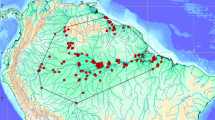Abstract
A 17 yr study of a population of the rose star Crossaster papposus (Linnaeus, 1767) in Auke Bay, near Juneau, Alaska, used SCUBA to follow a total of 956 individually marked stars. Population density was relatively constant over the 17 yr of study, although the influx of smaller individuals varied by an order of magnitude. Growth in diameter of individual stars was inversely related to size, with the largest individuals showing negligible growth for periods of months or years. Annual survivorship was relatively high (from 76.3 to 90.4%), and some individuals persisted throughout the study, indicating longevities of at least 20 yr in this species. Observations of food habits indicated that the principal prey item is the reddish scallop Chlamys rubida. In summary, this rose star population was characterized by a relatively stable number of long-lived, slow-growing individuals.
Similar content being viewed by others
Author information
Authors and Affiliations
Additional information
Received: 7 April 1998 / Accepted: 5 October 1998
Rights and permissions
About this article
Cite this article
Carlson, H., Pfister, C. A seventeen-year study of the rose star Crossaster papposus population in a coastal bay in southeast Alaska. Marine Biology 133, 223–230 (1999). https://doi.org/10.1007/s002270050461
Issue Date:
DOI: https://doi.org/10.1007/s002270050461




